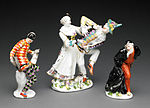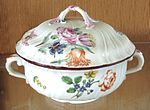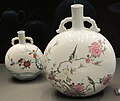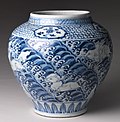Soft-paste porcelain (sometimes simply "soft paste", or "artificial porcelain") is a type of ceramic material in pottery, usually accepted as a type of...
24 KB (2,985 words) - 11:39, 5 June 2024
latter having some of the properties of hard-paste porcelain. Europeans also developed soft-paste porcelain, fired at lower temperatures (around 1200 °C)...
7 KB (770 words) - 07:51, 30 March 2024
decorated. Though definitions vary, porcelain can be divided into three main categories: hard-paste, soft-paste, and bone china. The categories differ...
59 KB (6,481 words) - 07:35, 12 September 2024
hard-paste porcelain known from Chinese and Japanese export porcelain. They succeeded in developing soft-paste porcelain, but Meissen porcelain was the...
21 KB (2,450 words) - 15:20, 30 June 2023
Meissen porcelain or Meissen china was the first European hard-paste porcelain. Early experiments were done in 1708 by Ehrenfried Walther von Tschirnhaus...
33 KB (3,856 words) - 06:18, 27 August 2024
Bone china (redirect from Bone porcelain)
making hard-paste porcelain (as made in East Asia and Meissen porcelain), but found bone ash a useful addition to their soft-paste porcelain mixtures. This...
13 KB (1,507 words) - 15:05, 4 September 2024
Medici porcelain was the first successful attempt in Europe to make imitations of Chinese porcelain, though it was soft-paste porcelain rather than the...
9 KB (1,010 words) - 10:56, 25 June 2024
Saint-Cloud porcelain was a type of soft-paste porcelain produced in the French town of Saint-Cloud from the late 17th to the mid 18th century. In 1702...
6 KB (581 words) - 11:48, 5 June 2024
China painting (redirect from Porcelain painter)
body of the object may be hard-paste porcelain, developed in China in the 7th or 8th century, or soft-paste porcelain (often bone china), developed in 18th-century...
58 KB (7,312 words) - 23:38, 4 May 2023
Rouen porcelain is soft-paste porcelain made in the city of Rouen, Normandy, France, during a brief period from about 1673 to 1696. It was the earliest...
8 KB (1,086 words) - 22:20, 14 March 2023
Chantilly porcelain is French soft-paste porcelain produced between 1730 and 1800 by the manufactory of Chantilly in Oise, France. The wares are usually...
10 KB (1,075 words) - 22:28, 26 July 2024
Limoges porcelain is hard-paste porcelain produced by factories in and around the city of Limoges, France, beginning in the late 18th century, by any...
4 KB (385 words) - 19:11, 7 July 2024
Mennecy-Villeroy porcelain (or Mennecy porcelain) is a French soft-paste porcelain from the manufactory established under the patronage of Louis-François-Anne...
7 KB (814 words) - 11:45, 5 June 2024
Manufacture nationale de Sèvres (redirect from Sèvres porcelain)
glass porcelain, which only has some qualities of the real thing...". Hard-paste porcelain began to be manufactured in Sèvres after 1770, but soft-paste was...
21 KB (2,557 words) - 20:51, 17 July 2024
porcelain factory that made soft-paste porcelain in Bristol from 1750 until 1752, when it merged with the young Worcester porcelain (see there for more information)...
7 KB (909 words) - 08:02, 20 April 2022
William Billingsley (artist) (category Porcelain painters)
influential painter of porcelain in several English porcelain factories, who also developed his own recipe for soft-paste porcelain, which produced beautiful...
11 KB (1,442 words) - 00:47, 1 August 2023
Royal Worcester (redirect from Worcester Porcelain)
of 20 tons p.a. of soaprock from Cornwall. The early wares were soft-paste porcelain with bodies that contained soaprock, commonly called in most ceramic...
18 KB (2,059 words) - 18:35, 15 May 2024
independently until 1770, when it was merged with Derby porcelain. It made soft-paste porcelain throughout its history, though there were several changes...
26 KB (3,357 words) - 00:10, 26 August 2024
Worcester porcelain; this was soft-paste porcelain. In 1770 the Plymouth porcelain factory, which made England's first hard-paste porcelain, moved to...
10 KB (1,153 words) - 11:49, 18 April 2022
Cleveland Museum of Art (Cleveland, Ohio, USA) Rococo vase; circa 1761; soft paste porcelain; height: 24.1 cm; Metropolitan Museum of Art Garden vase decorated...
8 KB (876 words) - 15:18, 19 August 2024
was built for moderately heavy use. Decorative elements such as soft-paste porcelain plaques were often inlaid into furniture pieces like wardrobes, commodes...
19 KB (2,009 words) - 14:56, 18 June 2024
Porcelain manufacturing companies are firms which manufacture porcelain. The table below lists European manufacturers of porcelain established before the...
19 KB (98 words) - 21:27, 23 December 2023
Famille jaune, noire, rose, verte (category Chinese porcelain)
falangcai porcelains Qing period Chinese export porcelain with European figure, famille rose, first half of 18th century Jingdezhen porcelain soft paste porcelain...
17 KB (1,914 words) - 08:17, 12 May 2024
of porcelain continued intermittently until 1835. Initially soft-paste porcelain was made, but some hard-paste porcelain from about 1765, though soft-paste...
9 KB (1,127 words) - 19:39, 2 November 2023
Ceramic art (section Porcelain)
body of the object may be hard-paste porcelain, developed in China in the 7th or 8th century, or soft-paste porcelain (often bone china), developed in 18th-century...
81 KB (9,464 words) - 19:29, 12 September 2024
1745; porcelain; diameter: 10.2 cm; Cleveland Museum of Art Sèvres cup and saucer, decorated with Gothic Revival ornaments and patterns; 1827; porcelain; overall:...
21 KB (1,905 words) - 20:28, 6 August 2024
Real Fábrica del Buen Retiro (section Porcelain rooms)
difficult. The factory continued to make soft paste porcelain until 1803, when it switched to hard-paste porcelain; some pieces made were in fact creamware...
12 KB (1,244 words) - 15:21, 2 September 2024
earliest hard-paste porcelain made in England, some two decades before Plymouth porcelain. The earliest Bow porcelains are of soft-paste incorporating...
18 KB (2,352 words) - 16:14, 13 March 2023
and used a similar soft-paste body. It was notable for Neoclassical subjects and styles, and figures in unglazed biscuit porcelain. By 1806, Napoleon...
22 KB (2,753 words) - 22:58, 9 May 2024
Blue and white pottery (redirect from Blue and white (porcelain))
European manufacture of porcelain started at Meissen in Germany in 1707. The detailed secrets of Chinese hard-paste porcelain technique were transmitted...
33 KB (3,569 words) - 12:16, 16 June 2024




























